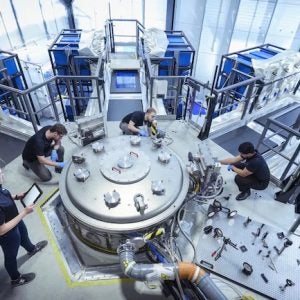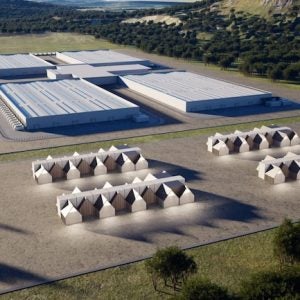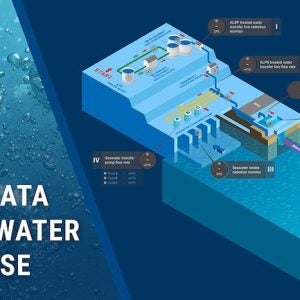It is generally accepted that the prime problem affecting nuclear power today is an economic one. On the one hand, there
are very few reactors under construction in the developed world on account of the high and escalating costs of constructing large reactors and the consequent difficulties of financing them. On the other, stiffer competition from gas-fired generating units and rising renewable shares of power generation are threatening many of the nuclear stations already in operation, despite their established record of achieving low and stable operating costs.
The difficulty of reaching the Final Investment Decision at the Hinkley Point C project in the UK highlights the former. Even when a supposedly liberalised power market is “adapted” to favour investment in a carbon-friendly large scale and mature technology, the magnitude of the required finance, the long timescales and the obvious risks of schedule overruns make it very difficult to secure the funds needed to go ahead. The revenue from the project may be guaranteed by the state (attracting criticism from those that argue that both energy security and lower carbon emissions
can be achieved by a combination of more gas-fired power and renewables) but that may not be enough if costs are high and threaten to run out of control.
The issues surrounding the continued operation of the 100 nuclear reactors in the US exemplify today’s new difficulties of plants already in operation. They can achieve 20 year extensions to their operating licences to 60 years (and maybe even to 80) so despite their long periods in service, they are regarded as safe. It may be that they are potential casualties of flawed power market designs, but the industry is doing everything it can to reduce costs and therefore improve their chances.
From the point of view of new reactors, it can be argued that the nuclear industry is rather exceptional and suffers from a high degree of government involvement. Ultimately it needs to move to small number of reactor designs which are safe and can be built cheaply in large numbers, using a fully internationalised supply chain. In normal industries, this would come about by natural wastage of unsuccessful companies getting taking over by those who are thriving and profitable, but this currently seems a forlorn hope in nuclear. National governments see nuclear as a strategic industry and will not let jobs wither away to competitors. Selling nuclear reactors to other countries becomes an arm of foreign policy. This will merely lead to a continuation of the current situation, where there are too many reactor designs offered by lots of different companies, all with a small number of orders. All of which are potentially too expensive.
There is, however, an important area of the nuclear business where things are rather different. Today we have very competitive uranium and enrichment markets, with prices which have fallen sharply from previous levels. This ensures cheap and abundant fuel for the huge amount of electricity produced remains a key advantage of nuclear. A common myth is that uranium is a commodity that is geologically scarce, difficult to mine, somehow special because of its magical powers and therefore likely to be very expensive. Yet uranium is actually relatively abundant and not awkward to separate from host minerals. So we should, therefore, expect it to be comparatively cheap. Yet a whole host of negative issues and emotions have historically surrounded it, which today have fallen away, and uranium is actually not so different to other commodities with “boom and bust” profiles.
Enrichment is no longer “special” as technology has usurped protectionism and emotion to bring much lower prices. The dominance of centrifuge technology today, which has replaced the former gaseous diffusion plants (GDPs), means that competition from cheap separative work units (SWUs) in producing the necessary enriched uranium emphasises the truth that uranium is not so special. Enrichment prices were for many years kept at excessive levels by a combination of high cost GDPs and the governmental protection that was provided to keep them in operation. The justification for this was a mixture of non- proliferation and domestic employment arguments. Enrichment is therefore an unusual example in nuclear where economic forces seem to have won out. Once centrifuge technology is mastered, it isn’t particularly difficult to produce lots of SWUs with prices determined by the marginal operating costs of the now universal centrifuge plants.
Nuclear’s economic problem is ultimately that people are afraid of it and this undoubtedly has a significant influence on the costs of building and operating plants. Even where public opinion is not strongly opposed to new reactor plans (such as in the UK and US) gaining and maintaining public accord is a key factor in project costs. The burden placed on nuclear plants by the national regulators is clearly substantial in financial terms but they are essentially the representatives of the general public. If the public has a deep fear of nuclear power, perhaps enhanced by observation of accidents in other countries, the regulator is effectively obligated to act on their behalf by placing higher hurdles for either new or operating plants.
So long as any incremental dose of radiation, however small, is regarded as potentially harmful, the nuclear industry has little chance of fulfilling its potential. It may now accept that future accidents are probably inevitable, but cannot claim that the consequences are manageable if evacuations of large numbers of people (as at Fukushima) are set to be part of this. Claims can be made for a fairer and more logical assessment of risks but the issues surrounding fear of radiation, notably potential mass evacuations of people from their homes, are exceptional and very hard to deal with. If the number of reactors around the world is going to be 1000 or 2000 rather than today’s 400, there are likely to be accidents with some offsite radiation releases more frequently than every 25 years or so. The industry has to be able to demonstrate that these are manageable and without severe risks for human wellbeing, but at the moment it clearly can’t.
The nuclear industry remains engaged in a substantial effort (via providing information via news services and websites)
which appeals solely to people’s rational side. All the evidence suggests that this will fail. More and more people may know that nuclear plants don’t emit much carbon and they can provide large quantities of secure power at affordable prices, but they won’t endorse it if there is even a small chance of them being evacuated from their homes because of it. Or at least their fellow citizens elsewhere in the country. It may well be that SMRs (small modular reactors) will prove to have a lot of virtues above today’s current large light water reactors but they will never succeed if there is any chance of an evacuation following an accident. It is essential that before they become widely available (which may be just at the point when governments understand the limitation of renewables) that the public have a much better understanding of radiation, with the constraints of the current regulatory regime removed. So the “rebranding of nuclear”, so much discussed post- Fukushima, actually needs a complete paradigm shift in how the world views nuclear technology, clearly no simple undertaking. The public certainly need to be better-informed about radiation but until there is clearer guidance on what is and isn’t safe, the industry can go nowhere. All the work on SMRs and new rector designs will be wasted unless the public fears about nuclear can be removed. Then the economics will begin to look right again and the industry can move forward.
As things stand, the better is perhaps the enemy of the sufficiently good. Given the fear that surrounds nuclear power, there is huge pressure on reactor designers to build in anything that promotes higher safety. And pressure is on the regulators to impose this as a standard irrespective of the financial cost. This then threatens to make nuclear power uneconomic. Yet do the latest designs actually offer more safety? If they do, why not shutdown all previous reactor designs? Yet the operating record of these units and all the calculations of deaths from different modes of electricity generation suggest that continued operation is very safe. The concept of “safer” when it comes to reactor design is therefore fundamentally flawed.
The industry’s response to its economic problem has been to try to hitch a ride on the global warming bus. I am not a climate change denier but this is a fatal distraction and delusion. Nobody has ever built a nuclear power station to curb carbon emissions. All of the 400 or so reactors currently in operation were built for other reasons. In particular, they were expected to produce a huge amount of power cheaply and reliably from a very limited raw material input, also conferring a higher degree of energy security on their hosts. This has indeed been their greatest success. The environmental benefit has been somewhat incidental.
It is impossible to sell a technology on the basis of what it doesn’t do. There are many different ways of averting greenhouse gases and as things stand, in almost every one of the 197 countries represented at last year’s Paris Agreement, nuclear is positioned a long way down the queue. With likely technical progress in renewable energy technologies (particularly in solar) and in energy storage, it falls further behind unless the nuclear industry itself can shift from the fear paradigm. Trying to be friends with the renewables advocates is essentially useless. The environmentalists are essentially anti economic growth and climate change is an issue now seemingly irretrievably linked to some combination of higher taxes and prices, bigger and more intrusive government intervention, lower economic growth, and less disposable income. The nuclear sector doesn’t want to be associated with any of this and should not be cosying up to anything that costs money.
Avoidance of carbon is not nuclear’s USP (unique selling proposition) but it certainly has this and a significant number
of other positive features, at least for those capable of rational analysis. But it has a UNP (unique negative proposition) in the shape of the paradigm of fear that surrounds it. The international radiological protection regime is merely the official manifestation of this, as a precautionary principle gradually destroys what should be a vibrant industry. If people are fearful and the regulator reaffirms that they are right, they will never take on board all the positive messages.
Ultimately, to those who do believe, no proof is necessary, and to those who do not believe, no proof is sufficient. Getting away from the mushroom cloud and James Bond movie images will certainly be tough, but it is achievable over a period of time. There are no quick fixes and the international industry needs to agree a strategy which will allow nuclear to prosper in the longer term. Public opinion is certainly local but even in countries where nuclear attracts better levels of public approval (such as in the UK) there is still an underlying fear factor. An international approach, but with communication vehicles channelled to local cultures and sensitivities, is certainly now urgently warranted.
In the end, nuclear certainly needs to break free and become more like other industrial sectors. The aircraft manufacturing sector is often taken as a good example. Air travel was once an expensive luxury available only to a few but now fleets of highly standardised planes send people cheaply from place to place. Air travel has become almost a basic service, so rather like the provision of electricity. Producing power with nuclear often seems rather expensive today, but it can be made a lot cheaper in future. The aircraft industry has not moved to supersonic transport as technological leaps sometimes don’t make economic sense. With something as basic as getting from A to B or powering your home, it makes good sense to perfect what we already have.
*Steve Kidd is an independent nuclear consultant and economist with East Cliff Consulting. The first half of his career was spent as an industrial economist within British industry, followed by nearly 18 years in senior positions at the World Nuclear Association and its predecessor organisation, the Uranium Institute.






